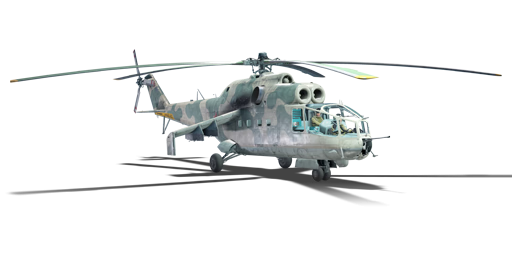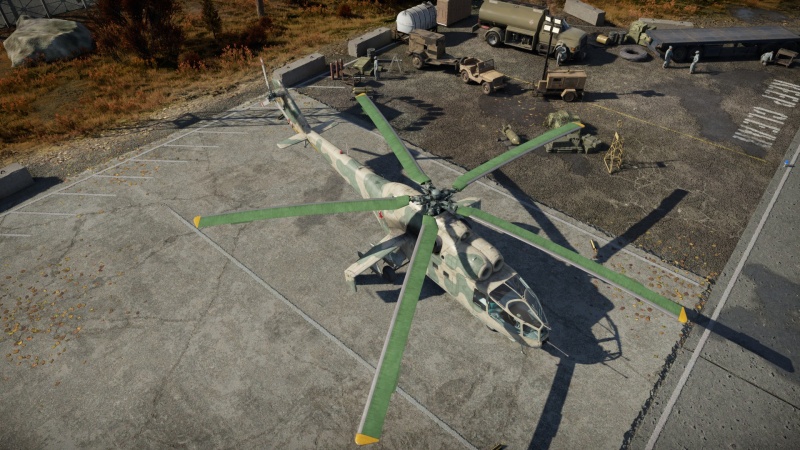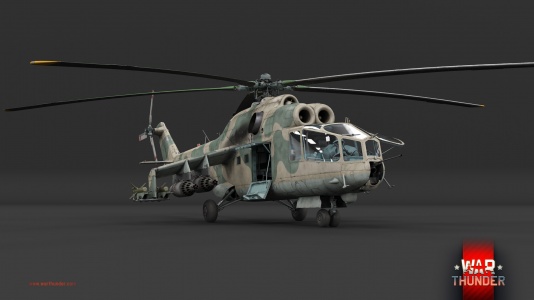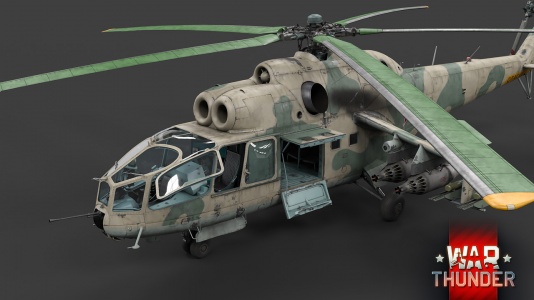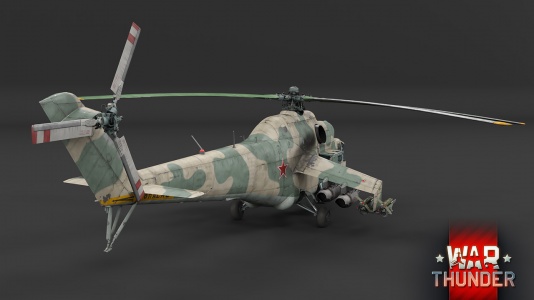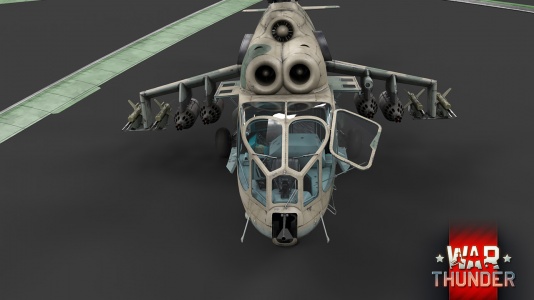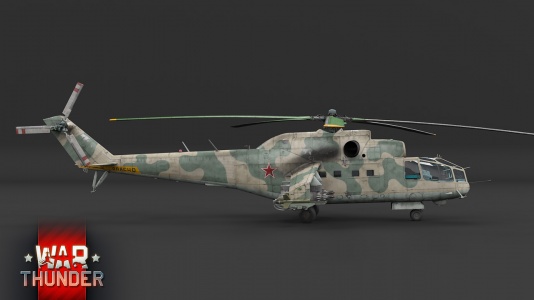Difference between revisions of "Mi-24A"
(Updated format) |
|||
| Line 1: | Line 1: | ||
| − | |||
| − | |||
| − | |||
| − | |||
{{About | {{About | ||
| about = Russian attack helicopter '''{{PAGENAME}}''' | | about = Russian attack helicopter '''{{PAGENAME}}''' | ||
| usage = other uses | | usage = other uses | ||
| link = Mi-24 (Family) | | link = Mi-24 (Family) | ||
| + | }} | ||
| + | {{Specs-Card | ||
| + | |code=mi_24a | ||
| + | |images={{Specs-Card-Image|GarageImage_{{PAGENAME}}.jpg}} | ||
}} | }} | ||
== Description == | == Description == | ||
<!-- ''In the description, the first part should be about the history of and the creation and combat usage of the helicopter, as well as its key features. In the second part, tell the reader about the helicopter in the game. Insert a screenshot of the vehicle, so that if the novice player does not remember the vehicle by name, he will immediately understand what kind of vehicle the article is talking about.'' --> | <!-- ''In the description, the first part should be about the history of and the creation and combat usage of the helicopter, as well as its key features. In the second part, tell the reader about the helicopter in the game. Insert a screenshot of the vehicle, so that if the novice player does not remember the vehicle by name, he will immediately understand what kind of vehicle the article is talking about.'' --> | ||
| − | |||
| − | |||
The '''{{Specs|name}}''' is a rank {{Specs|rank}} Soviet attack helicopter {{Battle-rating}}. It was introduced in [[Update 1.81 "The Valkyries"]]. | The '''{{Specs|name}}''' is a rank {{Specs|rank}} Soviet attack helicopter {{Battle-rating}}. It was introduced in [[Update 1.81 "The Valkyries"]]. | ||
| Line 22: | Line 20: | ||
{| class="wikitable" style="text-align:center" | {| class="wikitable" style="text-align:center" | ||
|- | |- | ||
| − | ! | + | ! rowspan="2" | Characteristics |
| − | |||
| − | |||
| − | |||
! colspan="2" | Max Speed<br>(km/h at 1,000 m) | ! colspan="2" | Max Speed<br>(km/h at 1,000 m) | ||
! rowspan="2" | Max altitude<br>(metres) | ! rowspan="2" | Max altitude<br>(metres) | ||
| Line 31: | Line 26: | ||
! AB !! RB | ! AB !! RB | ||
|- | |- | ||
| − | | 317 || 303 || | + | ! Stock |
| + | | 317 || 303 || rowspan="2" | {{Specs|ceiling}} | ||
|- | |- | ||
| − | ! | + | ! Upgraded |
| − | + | | ___ || 335 | |
| − | |||
| − | |||
| − | |||
| − | |||
| − | |||
| − | |||
|- | |- | ||
|} | |} | ||
| Line 55: | Line 45: | ||
=== Offensive armament === | === Offensive armament === | ||
{{Specs-Heli-Offensive}} | {{Specs-Heli-Offensive}} | ||
| − | <!-- ''Describe the offensive armament of the | + | <!-- ''Describe the offensive armament of the helicopter, if any. Describe how effective the cannons and machine guns are in battle, also what ammunition belts or drums are better to use. If there is no offensive weaponry, delete this subsection.'' --> |
{{main|A-12.7 (12.7 mm)}} | {{main|A-12.7 (12.7 mm)}} | ||
The '''''{{PAGENAME}}''''' is armed with: | The '''''{{PAGENAME}}''''' is armed with: | ||
| + | |||
* 1 x 12.7 mm A-12.7 machine gun, nose turret (900 rpg) | * 1 x 12.7 mm A-12.7 machine gun, nose turret (900 rpg) | ||
=== Suspended armament === | === Suspended armament === | ||
{{Specs-Heli-Suspended}} | {{Specs-Heli-Suspended}} | ||
| − | <!-- ''Describe the | + | <!-- ''Describe the helicopter's suspended armament: additional cannons under the winglets, any bombs, and rockets. Since any helicopter is essentially only a platform for suspended weaponry, this section is significant and deserves your special attention. If there is no suspended weaponry remove this subsection.'' --> |
| − | {{main|OFAB- | + | {{main|OFAB-250sv (250 kg)|FAB-500M-54 (500 kg)|FAB-500sv (500 kg)|9M17M Falanga|S-5K}} |
The '''''{{PAGENAME}}''''' can be outfitted with the following ordnance: | The '''''{{PAGENAME}}''''' can be outfitted with the following ordnance: | ||
| + | |||
* Without load | * Without load | ||
* 128 x S-5K rockets | * 128 x S-5K rockets | ||
* 4 x 9M17M Falanga missiles | * 4 x 9M17M Falanga missiles | ||
| − | * 4 x 250 kg OFAB- | + | * 4 x 250 kg OFAB-250sv bombs (1,000 kg total) |
* 2 x 500 kg FAB-500M-54 bombs (1,000 kg total) | * 2 x 500 kg FAB-500M-54 bombs (1,000 kg total) | ||
| − | * 128 x S-5K rockets | + | * 4 x 9M17M Falanga missiles + 128 x S-5K rockets |
| − | + | * 4 x 9M17M Falanga missiles + 4 x 250 kg OFAB-250sv bombs (1,000 kg total) | |
| − | * 2 x 500 kg FAB- | + | * 4 x 9M17M Falanga missiles + 2 x 500 kg FAB-500sv bombs (1,000 kg total) |
| − | * 2 x 250 kg OFAB- | + | * 4 x 9M17M Falanga missiles + 2 x 250 kg OFAB-250sv bombs + 64 x S-5K rockets (500 kg total) |
== Usage in battles == | == Usage in battles == | ||
| − | ''Describe the tactics of playing in a helicopter, the features of using helicopter in a team and advice on tactics. Refrain from creating a "guide" - do not impose a single point of view, but instead, give the reader food for thought. Examine the most dangerous enemies and give recommendations on fighting them. If necessary, note the specifics of the game in different modes (AB, RB, SB).'' | + | ''Describe the tactics of playing in a helicopter, the features of using the helicopter in a team and advice on tactics. Refrain from creating a "guide" - do not impose a single point of view, but instead, give the reader food for thought. Examine the most dangerous enemies and give recommendations on fighting them. If necessary, note the specifics of the game in different modes (AB, RB, SB).'' |
| − | |||
| − | |||
| − | |||
| − | |||
| − | |||
| − | |||
| − | |||
| − | |||
| − | |||
| − | |||
| − | |||
| − | |||
| − | |||
| − | |||
| − | |||
| − | |||
| − | |||
| − | |||
| − | |||
| − | |||
| − | |||
| − | |||
| − | |||
| − | |||
| − | |||
| − | |||
| − | |||
| − | |||
| − | |||
| − | |||
| − | |||
| − | |||
| − | |||
| − | |||
| − | |||
| − | |||
| − | |||
| − | |||
| − | |||
| − | |||
| − | |||
=== Pros and cons === | === Pros and cons === | ||
| Line 134: | Line 85: | ||
In studying the possibilities of helicopter design and the experience of other countries, Mikhail Leontyevich Mil came to the conclusion that a well-armed and armored battle helicopter was required to increase the mobility of the Soviet Army. It had to be capable of transporting cargos and paratroopers – a kind of flying armored car. In contrast to the American army, in which troop transport helicopters operated with cover from assault helicopters, Mikhail decided to create a vehicle that could handle both these tasks on its own. The engineers at the Mil design bureau already had considerable experience in developing helicopters, and had performed several experiments in transforming transport helicopters into assault helicopters. This meant that after military officials approved the concept of an assault-transport helicopter, the team immediately got to work. In the summer of 1969, literally a year after the work had begun, the Mil engineers presented a prototype for testing. | In studying the possibilities of helicopter design and the experience of other countries, Mikhail Leontyevich Mil came to the conclusion that a well-armed and armored battle helicopter was required to increase the mobility of the Soviet Army. It had to be capable of transporting cargos and paratroopers – a kind of flying armored car. In contrast to the American army, in which troop transport helicopters operated with cover from assault helicopters, Mikhail decided to create a vehicle that could handle both these tasks on its own. The engineers at the Mil design bureau already had considerable experience in developing helicopters, and had performed several experiments in transforming transport helicopters into assault helicopters. This meant that after military officials approved the concept of an assault-transport helicopter, the team immediately got to work. In the summer of 1969, literally a year after the work had begun, the Mil engineers presented a prototype for testing. | ||
| − | The first version of the Mi-24 already had the characteristics and features familiar to all fans of military vehicles found in the later series-produced versions, the Mi-24B and the Mi-24D. The characteristic silhouette for which the Mi-24 was dubbed | + | The first version of the Mi-24 already had the characteristics and features familiar to all fans of military vehicles found in the later series-produced versions, the Mi-24B and the Mi-24D. The characteristic silhouette for which the Mi-24 was dubbed "Hind", two TVZ-117 turboshaft engines, retractable landing gear, a cargo bay for paratroopers and wings for mounting weaponry. However, there were differences also. The tail rotor on the Mi-24A was placed on the right – it was only moved to the left side in 1974. A single cabin was mounted on the Mi-24A with a flat glass, a so-called "Veranda" in which the armament operator and the pilot could sit one behind the other with a slight offset. The main difference was the armament. By the time the Mi-24 was created, the weaponry that the military demanded for the new helicopter – modern Shturm ATGMs with an advanced aiming kit, and a rapid-firing machine gun for the rotating nose turret – was not yet ready. The first versions of the Mi-24 were equipped with the Falanga-MV ATGM with manual aiming, the single-barrel A-12.7 in a turret with limited mobility on the nose with a simple collimator sight, and unguided rockets or up to 1000 kg of bombs on the wing hardpoints. Officially, the Mi-24A was never accepted into service, although quite a lot of the vehicles were built – along with the training versions, over 240 in total. The Mi-24A was exported, and took part in military operations in Ethiopia, Afghanistan and Libya. |
''- From [[wt:en/news/5736-development-mi-24a-the-impeccable-hind-en|Devblog]]'' | ''- From [[wt:en/news/5736-development-mi-24a-the-impeccable-hind-en|Devblog]]'' | ||
| Line 145: | Line 96: | ||
;Images | ;Images | ||
| − | < | + | <gallery mode="packed" heights="200"> |
| − | + | File:Mi-24A WTWallpaper 001.jpg | |
| − | + | File:Mi-24A WTWallpaper 002.jpg | |
| − | + | File:Mi-24A WTWallpaper 003.jpg | |
| − | + | File:Mi-24A WTWallpaper 004.jpg | |
| − | + | File:Mi-24A WTWallpaper 005.jpg | |
| − | </ | + | </gallery> |
;Videos | ;Videos | ||
Revision as of 13:30, 25 December 2020
| This page is about the Russian attack helicopter Mi-24A. For other uses, see Mi-24 (Family). |
Contents
Description
The Mi-24A is a rank V Soviet attack helicopter with a battle rating of 9.3 (AB), 8.7 (RB), and 9.0 (SB). It was introduced in Update 1.81 "The Valkyries".
General info
Flight performance
Describe how the helicopter behaves in the air. Speed, manoeuvrability, acceleration and allowable loads - these are the most important characteristics of the vehicle.
| Characteristics | Max Speed (km/h at 1,000 m) |
Max altitude (metres) | |
|---|---|---|---|
| AB | RB | ||
| Stock | 317 | 303 | 4950 |
| Upgraded | ___ | 335 | |
Survivability and armour
Examine the survivability of the helicopter. Note how vulnerable the structure is and how secure the pilot is, whether the fuel tanks are armoured, etc. Describe the armour, if there is any, and also mention the vulnerability of other critical systems.
Modifications and economy
Armaments
Offensive armament
The Mi-24A is armed with:
- 1 x 12.7 mm A-12.7 machine gun, nose turret (900 rpg)
Suspended armament
The Mi-24A can be outfitted with the following ordnance:
- Without load
- 128 x S-5K rockets
- 4 x 9M17M Falanga missiles
- 4 x 250 kg OFAB-250sv bombs (1,000 kg total)
- 2 x 500 kg FAB-500M-54 bombs (1,000 kg total)
- 4 x 9M17M Falanga missiles + 128 x S-5K rockets
- 4 x 9M17M Falanga missiles + 4 x 250 kg OFAB-250sv bombs (1,000 kg total)
- 4 x 9M17M Falanga missiles + 2 x 500 kg FAB-500sv bombs (1,000 kg total)
- 4 x 9M17M Falanga missiles + 2 x 250 kg OFAB-250sv bombs + 64 x S-5K rockets (500 kg total)
Usage in battles
Describe the tactics of playing in a helicopter, the features of using the helicopter in a team and advice on tactics. Refrain from creating a "guide" - do not impose a single point of view, but instead, give the reader food for thought. Examine the most dangerous enemies and give recommendations on fighting them. If necessary, note the specifics of the game in different modes (AB, RB, SB).
Pros and cons
Summarise and briefly evaluate the vehicle in terms of its characteristics and combat effectiveness. Mark its pros and cons in the bulleted list. Try not to use more than 6 points for each of the characteristics. Avoid using categorical definitions such as "bad", "good" and the like - use substitutions with softer forms such as "inadequate" and "effective".
Pros:
Cons:
History
In studying the possibilities of helicopter design and the experience of other countries, Mikhail Leontyevich Mil came to the conclusion that a well-armed and armored battle helicopter was required to increase the mobility of the Soviet Army. It had to be capable of transporting cargos and paratroopers – a kind of flying armored car. In contrast to the American army, in which troop transport helicopters operated with cover from assault helicopters, Mikhail decided to create a vehicle that could handle both these tasks on its own. The engineers at the Mil design bureau already had considerable experience in developing helicopters, and had performed several experiments in transforming transport helicopters into assault helicopters. This meant that after military officials approved the concept of an assault-transport helicopter, the team immediately got to work. In the summer of 1969, literally a year after the work had begun, the Mil engineers presented a prototype for testing.
The first version of the Mi-24 already had the characteristics and features familiar to all fans of military vehicles found in the later series-produced versions, the Mi-24B and the Mi-24D. The characteristic silhouette for which the Mi-24 was dubbed "Hind", two TVZ-117 turboshaft engines, retractable landing gear, a cargo bay for paratroopers and wings for mounting weaponry. However, there were differences also. The tail rotor on the Mi-24A was placed on the right – it was only moved to the left side in 1974. A single cabin was mounted on the Mi-24A with a flat glass, a so-called "Veranda" in which the armament operator and the pilot could sit one behind the other with a slight offset. The main difference was the armament. By the time the Mi-24 was created, the weaponry that the military demanded for the new helicopter – modern Shturm ATGMs with an advanced aiming kit, and a rapid-firing machine gun for the rotating nose turret – was not yet ready. The first versions of the Mi-24 were equipped with the Falanga-MV ATGM with manual aiming, the single-barrel A-12.7 in a turret with limited mobility on the nose with a simple collimator sight, and unguided rockets or up to 1000 kg of bombs on the wing hardpoints. Officially, the Mi-24A was never accepted into service, although quite a lot of the vehicles were built – along with the training versions, over 240 in total. The Mi-24A was exported, and took part in military operations in Ethiopia, Afghanistan and Libya.
- From Devblog
Media
- Skins
- Images
- Videos
See also
Links to the articles on the War Thunder Wiki that you think will be useful for the reader, for example:
- reference to the series of the helicopter;
- links to approximate analogues of other nations and research trees.
External links
| Mil Moscow Helicopter Plant | |
|---|---|
| Attack | Mi-4AV |
| Mi-8AMTSh · Mi-8AMTSh-VN · Mi-8TV | |
| Mi-24A · Mi-24P · Mi-24V | |
| Mi-28N · Mi-28NM | |
| Mi-35M | |
| Export | ◊Mi-8TB |
| ▂Mi-24D · ◔Mi-24D · ◔Mi-24V · ◔Mi-24P · ◊Mi-24P · ◄Mi-24P HFS 80 · Superhind | |
| Mi-28A | |
| ▄Mi-35M | |
| USSR helicopters | |
|---|---|
| Attack | |
| Hound | Mi-4AV |
| Hip | Mi-8AMTSh · Mi-8AMTSh-VN · Mi-8TV |
| Hind | Mi-24A · ▂Mi-24D · Mi-24P · Mi-24V · Mi-35M |
| Havoc | Mi-28N · Mi-28NM |
| Helix | Ka-29 |
| Hokum | Ka-50 · Ka-52 |


